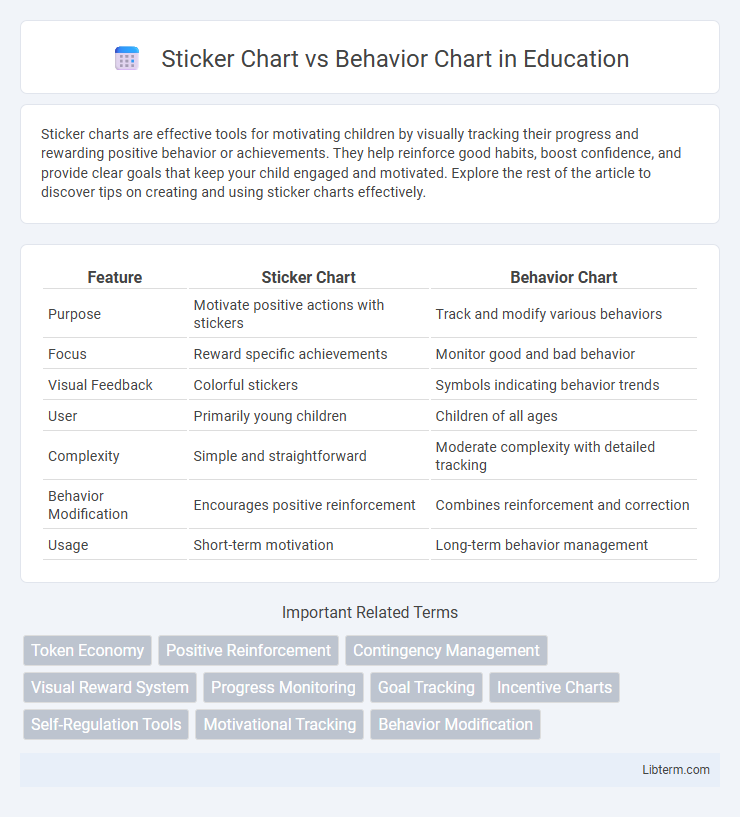Sticker charts are effective tools for motivating children by visually tracking their progress and rewarding positive behavior or achievements. They help reinforce good habits, boost confidence, and provide clear goals that keep your child engaged and motivated. Explore the rest of the article to discover tips on creating and using sticker charts effectively.
Table of Comparison
| Feature | Sticker Chart | Behavior Chart |
|---|---|---|
| Purpose | Motivate positive actions with stickers | Track and modify various behaviors |
| Focus | Reward specific achievements | Monitor good and bad behavior |
| Visual Feedback | Colorful stickers | Symbols indicating behavior trends |
| User | Primarily young children | Children of all ages |
| Complexity | Simple and straightforward | Moderate complexity with detailed tracking |
| Behavior Modification | Encourages positive reinforcement | Combines reinforcement and correction |
| Usage | Short-term motivation | Long-term behavior management |
Introduction to Sticker Charts and Behavior Charts
Sticker charts and behavior charts are visual tools used to reinforce positive behavior in children by tracking progress and rewarding achievements. Sticker charts involve placing stickers or markers on a grid to motivate children through tangible rewards for completing tasks or exhibiting desired behaviors. Behavior charts, on the other hand, provide a structured way to monitor and manage behavior by rating actions or assigning points, often incorporating clear goals and consequences to guide improvement.
Purpose and Goals of Each Chart System
Sticker charts primarily aim to motivate children by providing immediate positive reinforcement for specific tasks or behaviors, using visual rewards that encourage consistency and achievement. Behavior charts focus on tracking a broader range of actions to identify patterns, promote self-regulation, and support long-term behavior modification through structured feedback. Both systems intend to foster positive habits but differ in scope, with sticker charts emphasizing short-term motivation and behavior charts targeting comprehensive behavioral development.
Key Differences Between Sticker Charts and Behavior Charts
Sticker charts emphasize rewarding specific tasks or achievements with visual stickers to motivate children through positive reinforcement, while behavior charts monitor and track overall behavior patterns, highlighting progress or areas for improvement. Sticker charts are typically task-oriented and celebratory, focusing on short-term goals, whereas behavior charts provide a broader view of behavioral consistency and self-discipline development. The key difference lies in the purpose: sticker charts encourage completing discrete actions, and behavior charts aim to modify and manage ongoing behavior.
Pros and Cons of Sticker Charts
Sticker charts offer a simple, visual way to encourage positive behavior by providing immediate rewards and motivation, making them especially effective for young children. However, they may lose effectiveness over time as children become desensitized to the stickers or if the rewards are not meaningful enough. Sticker charts require consistent tracking and can sometimes emphasize external rewards over intrinsic motivation, potentially limiting long-term behavioral change.
Pros and Cons of Behavior Charts
Behavior charts effectively track and reinforce positive actions by providing clear expectations and immediate feedback, which helps improve children's self-discipline and responsibility. However, they can sometimes lead to over-reliance on external rewards, potentially diminishing intrinsic motivation and causing stress if expectations are too rigid. Proper implementation requires balancing positive reinforcement with support to ensure behavior charts promote lasting behavioral change.
Situations Best Suited for Sticker Charts
Sticker charts are ideal for motivating young children in early learning or behavior development by providing visual and tangible rewards for positive actions. They work best in environments where goal-setting is clear, such as completing homework, practicing hygiene routines, or demonstrating polite behavior. These charts promote consistent reinforcement and help build self-esteem by offering a simple, immediate recognition system for small achievements.
When to Use a Behavior Chart Instead
Use a behavior chart instead of a sticker chart when tracking complex or ongoing behavior patterns that require detailed feedback and consistent monitoring. Behavior charts effectively address specific conduct issues, such as classroom disruptions or emotional regulation, by providing clear expectations and measurable goals over time. This approach is ideal for reinforcing long-term behavioral change rather than simple task completion or immediate rewards.
Common Mistakes to Avoid with Both Chart Types
Common mistakes to avoid with sticker charts and behavior charts include setting unclear goals that confuse children and failing to provide immediate reinforcement, which undermines motivation. Overusing these charts can lead to dependency on external rewards rather than fostering intrinsic behavior change. Consistency in tracking and positive feedback is crucial to ensure the effectiveness of both chart types.
Tips for Maximizing Chart Effectiveness
To maximize the effectiveness of sticker charts and behavior charts, set clear, specific goals that are achievable and measurable for the child. Use consistent positive reinforcement by rewarding progress immediately to encourage motivation and reinforcement of desired behaviors. Regularly review and adjust the charts based on the child's responsiveness and developmental needs to maintain engagement and ensure sustained behavioral improvement.
Choosing the Right Chart for Your Child
Selecting the right chart depends on your child's motivation and developmental needs. Sticker charts work well for younger children or those who respond positively to visual rewards and immediate reinforcement. Behavior charts suit older children, focusing on tracking progress and promoting self-regulation through clear goal-setting and consequences.
Sticker Chart Infographic

 libterm.com
libterm.com